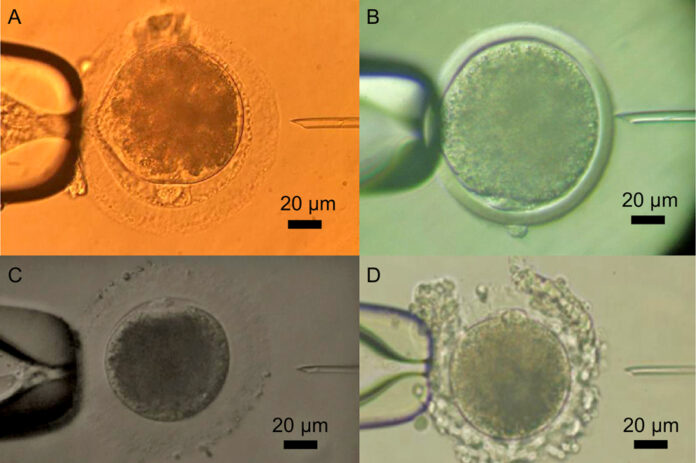Intracytoplasmic sperm injection (ICSI) has become a transformative technique in the field of reproductive biology, particularly in animal breeding and conservation. This advanced micromanipulation method involves the direct injection of a single sperm cell into a mature oocyte, effectively bypassing the natural fertilization process. Initially developed for human infertility treatments, ICSI has found applications in various animal species, including livestock and endangered species. However, while ICSI presents numerous advantages, it also raises significant concerns regarding the health and welfare of the animals involved, as well as ethical considerations surrounding its use.
The promise of ICSI lies in its ability to address infertility issues that may arise from various factors, including age, genetic abnormalities, or poor sperm quality. In domestic animals, such as cattle and sheep, ICSI can facilitate the breeding of genetically superior individuals, thereby enhancing productivity and improving herd quality. This is particularly beneficial in the context of livestock farming, where maximizing genetic potential is crucial for economic viability. By allowing the use of sperm from elite sires, ICSI can help maintain genetic diversity and prevent the loss of valuable traits that might otherwise occur through conventional breeding methods.
In addition to its applications in agriculture, ICSI plays a vital role in conservation efforts for endangered species. Many species face reproductive challenges due to a limited gene pool, habitat loss, and other environmental pressures. ICSI offers a glimmer of hope by enabling the use of cryopreserved sperm from genetically valuable individuals, thus preserving genetic material that can be used to bolster populations. For example, ICSI has been successfully employed in species such as the giant panda, where traditional breeding methods have proven difficult. By facilitating the creation of viable embryos, ICSI can contribute to the recovery of populations that are on the brink of extinction.
Despite its potential benefits, the use of ICSI in animals is not without its drawbacks. One of the primary concerns is the risk of developmental abnormalities in offspring. Research has shown that ICSI can lead to conditions such as “large offspring syndrome” (LOS) in ruminants, characterized by increased birth weight and associated complications. This syndrome is thought to result from improper embryo culture conditions and may have long-term implications for the health of the offspring. Studies have indicated that animals produced through ICSI may be more susceptible to metabolic disorders and other health issues, raising questions about the overall welfare of these individuals.
Moreover, the technique of ICSI itself can introduce genetic concerns. Abnormal chromosome segregation during the first mitotic division can result in embryos that do not develop normally or lead to spontaneous abortions. This raises significant questions about the genetic integrity of the offspring produced through ICSI. Long-term studies in rodent models have revealed various health risks associated with ICSI, including aberrant transcriptional changes that persist into adulthood. These changes can manifest as altered glucose metabolism, decreased reproductive capacity, and increased susceptibility to diseases.
In addition to these health risks, ICSI has been linked to behavioural issues in offspring. Research in mice has shown that females produced through ICSI exhibit increased anxiety, deficits in spatial memory, and other cognitive impairments. Such findings highlight the potential for ICSI to affect not only the physical health of animals but also their behavioural and psychological well-being. The implications of these findings are particularly concerning in the context of conservation, where the survival of endangered species often hinges on their ability to adapt to changing environments and social structures.
The intracytoplasmic sperm injection represents a significant advancement in the field of animal reproduction, offering promising solutions for infertility and conservation challenges. However, the potential risks and ethical concerns associated with its use cannot be overlooked. As we continue to explore the applications of ICSI in animals, it is essential to approach this technology with caution and consideration for the welfare of the animals involved. By carefully weighing the risks and benefits and prioritizing animal welfare in research and policy, we can work towards a future where the promise of ICSI is realized while minimizing the potential for harm.
Another significant concern surrounding ICSI is the ethical implications of manipulating reproductive processes in animals. Critics argue that the use of advanced reproductive technologies can violate the integrity and autonomy of animals, leading to ethical dilemmas regarding their treatment and welfare. The manipulation of reproductive processes raises questions about the naturalness of breeding and the potential for harm to the animals involved. Many people believe that interventions like ICSI cross a line between natural and unnatural processes, potentially leading to suffering and distress for the animals.
Public sentiment regarding the use of ICSI in animals is increasingly critical, with growing calls for transparency and accountability in the application of reproductive technologies. Animal rights advocates argue that the welfare of individual animals must be prioritized over the potential benefits to agriculture or conservation. This perspective emphasizes the importance of considering the emotional and psychological well-being of animals, as well as their physical health. As society becomes more aware of the ethical implications of animal research and breeding practices, it is essential that scientists and policymakers engage in open dialogues about the responsible use of technologies like ICSI.
Regulatory oversight is another crucial aspect of the discussion surrounding ICSI in animals. As the use of this technology continues to expand, it is imperative that regulatory bodies establish guidelines and standards to ensure the welfare of the animals involved. This includes evaluating the necessity and justification for using ICSI in various contexts, particularly when it may cause distress or harm to the animals. Ongoing research and careful monitoring are essential to address the potential health risks associated with ICSI and to ensure that the benefits of the technology are realized without compromising animal welfare.
In light of these concerns, it is essential to adopt a balanced approach to the use of ICSI in animals. While the technique offers significant potential benefits for breeding and conservation, it is crucial to prioritize animal welfare and ethical considerations. Researchers and practitioners must continue to explore ways to optimize ICSI and minimize the risks of developmental abnormalities and long-term health issues. This includes refining the techniques used in ICSI, improving embryo culture conditions, and conducting long-term studies to fully understand the implications of ICSI on animal health and well-being.
Moreover, there is a need for interdisciplinary collaboration among scientists, ethicists, policymakers, and the public to ensure that the use of ICSI aligns with societal values and ethical standards. By fostering open dialogues and engaging diverse perspectives, stakeholders can work together to develop responsible practices that prioritize the welfare of animals while harnessing the potential of advanced reproductive technologies.
The intracytoplasmic sperm injection represents a significant advancement in the field of animal reproduction, offering promising solutions for infertility and conservation challenges. However, the potential risks and ethical concerns associated with its use cannot be overlooked. As we continue to explore the applications of ICSI in animals, it is essential to approach this technology with caution and consideration for the welfare of the animals involved. By carefully weighing the risks and benefits and prioritizing animal welfare in research and policy, we can work towards a future where the promise of ICSI is realized while minimizing the potential for harm. The journey ahead requires a commitment to ethical practices, ongoing research, and a deep respect for the animals that contribute to our understanding of reproductive biology.























